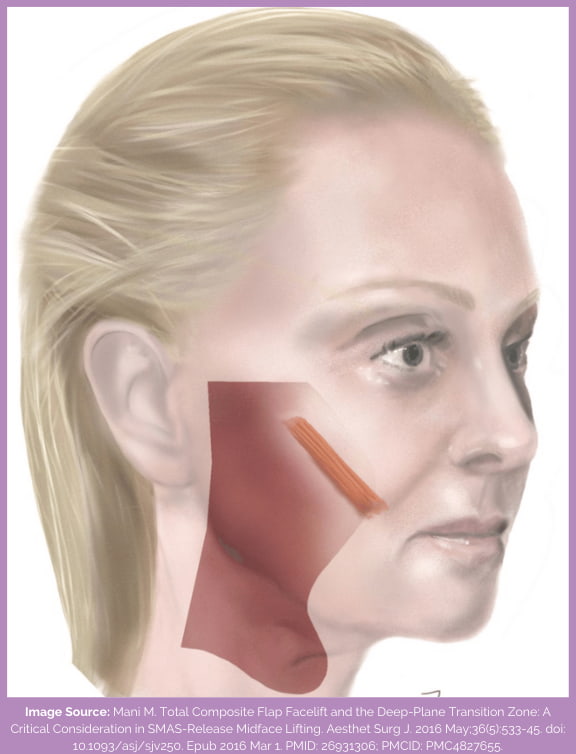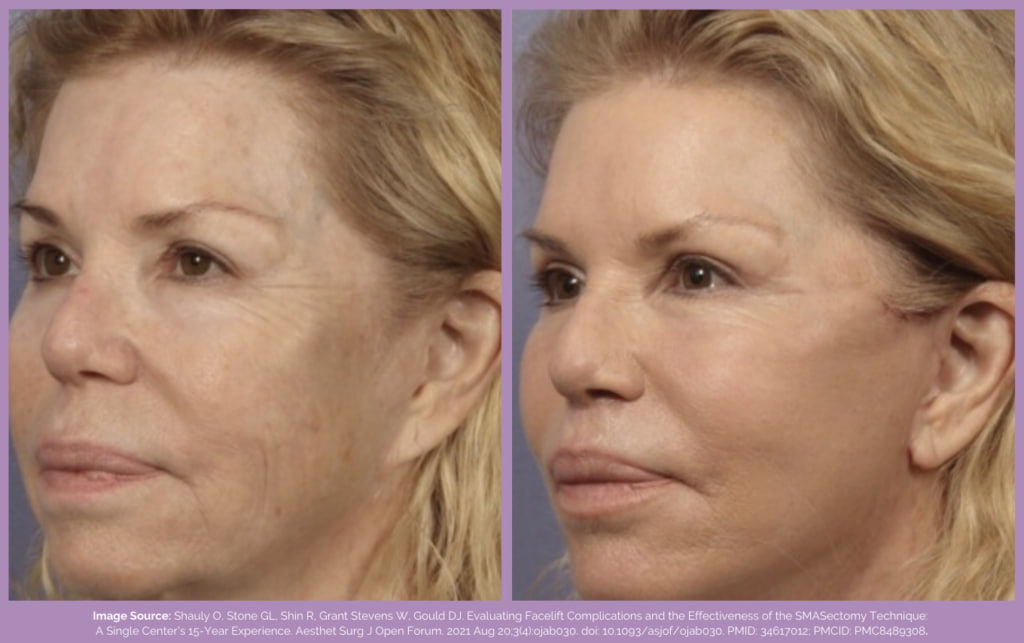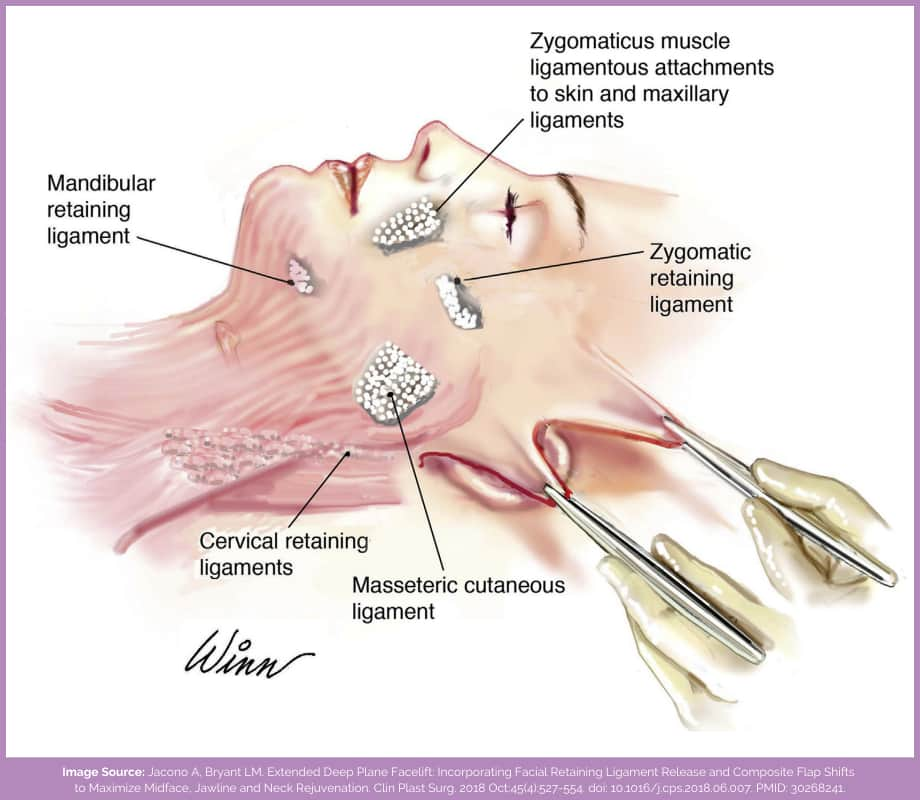SMAS, which stands for the superficial musculoaponeurotic system, is a type of facial tissue that’s targeted for surgical facelifts. While there are different techniques to go about it, the end goal is to redrape this tissue to lift the face.
It can help address different signs of ageing in the lower half of the face and even the neck as well. And its results are, of course, more dramatic than the old facelift technique in which only the excess skin was addressed. That’s because it goes further to treat underlying droopy muscle as well.
Even so, you might easily feel confused about whether or not this technique will best meet your needs. While that’s something that only your surgeon can guide you on, here, you’ll get a better understanding of what a SMAS lift actually is.
What Is A SMAS Facelift?
SMAS facelift is a cosmetic surgical procedure in which a tissue, called the superficial musculoaponeurotic system, present underneath the skin, is lifted through different techniques, such as:
- Plication – In which the SMAS muscle is folded and sutured.
- Imbrication – A piece of the SMAS muscle is cut out, and the edges are “imbricated” or overlapped before being stitched back up.
- Lateral SMASectomy – A piece of the SMAS specifically overlying the front edge of the parotid (salivary) gland is cut out and then sutured.

SMAS facelift was a step ahead of the old face surgeries in which only the overlying skin was taken care of. As reported in a study published in the Archives of Facial Plastic Surgery, it was a Swedish plastic surgeon, Tord Skoog, who first developed this technique back in 1968, which allowed him to lift the platysma in the neck and the lower face as well.
But it’s very important to note the distinction of its target areas. According to research published in Facial Plastic Surgery, traditional SMAS facelifts do not do anything for the midface area and nasolabial folds (creases around the mouth that become more prominent with age).
With that, there were further developments in its techniques, which led to extended and high SMAS facelifts addressing the midface areas as well. But again, which treatment will best suit your needs depends on different factors, such as the extent of facial ageing, your actual age, cosmetic goals, etc.
How Painful Is A SMAS Facelift?
SMAS facelift is performed under general anaesthesia, so you should not feel pain during the surgery. Afterwards, however, you may feel pain, but your surgeon should prescribe painkillers for this.
How Long Does A SMAS Facelift Last?
A SMAS facelift can last for 10 to 15 years. It’s not permanent, but there’s no stopping the ageing process even after you’ve had the surgery.

Although, of course, with this surgery, you’ll have fewer signs of ageing on your face than you typically would have at that age. You can have another facelift, but when you need it can depend on the type of facelift you have and the age at which you get it.
How Much Does A SMAS Facelift Cost?
In the UK, an SMAS facelift might cost you somewhere around £8,000 to £10,000. The price can vary depending on the complexity of the procedure, the experience of the surgeon and the location of the location. Some clinics do offer the option for flexible payment plans.
Some also choose to come to Turkey as medical tourists since the surgery can be 3-5 times cheaper there, owing to the currency exchange rate and the economic differences. Here, you might be able to get this procedure for around £2,500 to £3,000.
How Long Is The Recovery Period For SMAS Facelift?
SMAS facelift can have a downtime of 1-2 weeks. But after the surgery, you may experience the following side effects:
- Swelling
- Bruising
- Tightness
- Pain
- Numbness
They should resolve on their own after some time. Swelling, in particular, can take the longest to go away. Although most of it should subside after 6 weeks, it can take 6-12 months for it to completely go away. That’s when you can see the final results of your SMAS facelift.
For some time, your surgeon may advise you to not engage in strenuous activities and avoid smoking since they can affect your healing process. For a week or so, you might also have to wear a neck support and be careful about sleeping on your back at an angle to help with the swelling.
Is A SMAS Facelift Worth It?
SMAS facelift has a “Worth It” rating of 85% on Reaself. This procedure can help address milder signs of ageing, especially in younger patients (between the ages of 30 and 40, although there can be variations).

However, it might be best suited for those who have slight jowling and issues with skin laxity. For more significant signs of ageing, your surgeon might recommend a deep plane facelift instead.
In a deep plane, SMAS imbrication is combined with the release of certain ligaments to allow for a better-pulling back of the SMAS. As a result, when the skin is draped back, the overall contour is much smoother. Your surgeon needs to assess you to determine which technique will be better for you.

Is A SMAS Facelift Safe?
In general, SMAS facelifts are relatively safe. However, you must find an experienced board-certified surgeon to perform this on you. Even so, you should know that this procedure is not completely without risks, as it can cause
- Skin necrosis
- Infection
- Scarring
- Nerve injury
- Hematoma
It can cause other complications as well, such as contour irregularities. Make sure to ask your surgeon about all of them so you can be better prepared and seek timely help.
Conclusion
A SMAS facelift is just one of the techniques for a surgical facelift. As is in the name, it targets the SMAS muscle in the face, which lies underneath the skin.
But it should be noted that there’s no one type of SMAS facelift. There are plenty of techniques that can be used to address different concerns in different areas of the face.
While you may have a good idea of which kind of facelift will best meet your needs, you must consult a board-certified and explain your goals and expectations to them so your treatment plan is made accordingly.
Reviewed and approved by Prof Dr Fuat Yuksel
FAQ
Is SMAS a mini facelift?
A SMAS facelift isn’t the same as a mini facelift because the area of dissection is much larger in the former. In a mini facelift, a small flap of the skin is lifted to tighten the underlying muscles and cut off the excess. In SMAS, a larger flap of skin may be lifted to tighten the underlying SMAS and get rid of the excess skin. Therefore, SMAS’ results can be more dramatic.
Does a SMAS facelift include the neck?
SMAS facelift addresses both the lower half of the face and the neck. It should be noted that SMAS is often believed to be an extension of the platysma in the neck, so it can have an effect there.
What age is SMAS facelift for?
Since the SMAS facelift might not address more significant signs of ageing, it might be best suited for those in their 30s and 40s. However, only a surgeon can best advise you on this.
What is the difference between a facelift and a SMAS facelift?
SMAS facelift is also a facelift, only it’s a different family of techniques with a focus on tightening and elevating the SMAS muscle in the face. There are others, like full facelifts, mini facelifts, deep plane facelifts, etc., to address different concerns in other parts of the face. Make sure to consult your surgeon on this as well.

